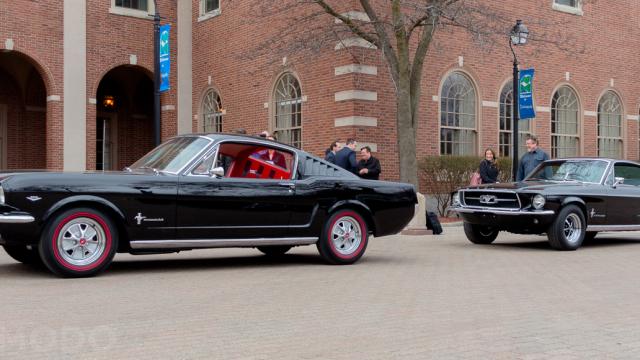This week the Ford Mustang, perhaps America’s most culturally influential car, turned 50. Ford Motor Company celebrated the anniversary with commemorative models and publicity stunts, but the company’s top two designers had the most fitting tribute: A Michigan-to-NYC road trip in two classic Mustangs. I rode along and, while the vehicles were vintage, the conversation was all about the future — of design, of cities, and yes, of cars.
Full disclosure: Ford Motor Company wanted me to ride shotgun on this trip so badly, it paid for my flight to Detroit and for two nights’ accommodations to boot. Not to mention, enough gasoline to hurtle two thirsty pony cars across an international border.
On April 17th, 1964, Ford Motor Company unveiled the original Mustang at the World’s Fair in New York City. After the fair ended, a few Ford engineers drove the two display Mustangs back to Ford’s world headquarters in Dearborn, MI, winding through central New York, swinging through the Canadian border at Niagara Falls, then cutting back into Michigan.
Our trip was to be a homecoming of sorts, the 50-years-delayed return voyage to the place where it all began. Ford’s head of design, Moray Callum, was at the wheel of a 1967 Mustang, while Chris Svensson, director of design for the Americas, helmed a 1965. These are Moray’s and Chris’s personal cars, both fresh from an immaculate restoration. This would be their maiden voyage, the first shakedown run. For this reason, we were joined by Matt Patrice, the master mechanic who just the day before had completed the rebuild of the two cars, and a yards-long trailer that would double as a rolling workshop should things go wrong.
Ford also offered to load a pair of 2014 Mustang Boss 302s in the trailer for backup, in case the classic ‘Stangs broke down. Moray turned down the offer on purist grounds. This decision would prove momentous.
Dearborn, Michigan

Chris Svensson’s 1965 Mustang.
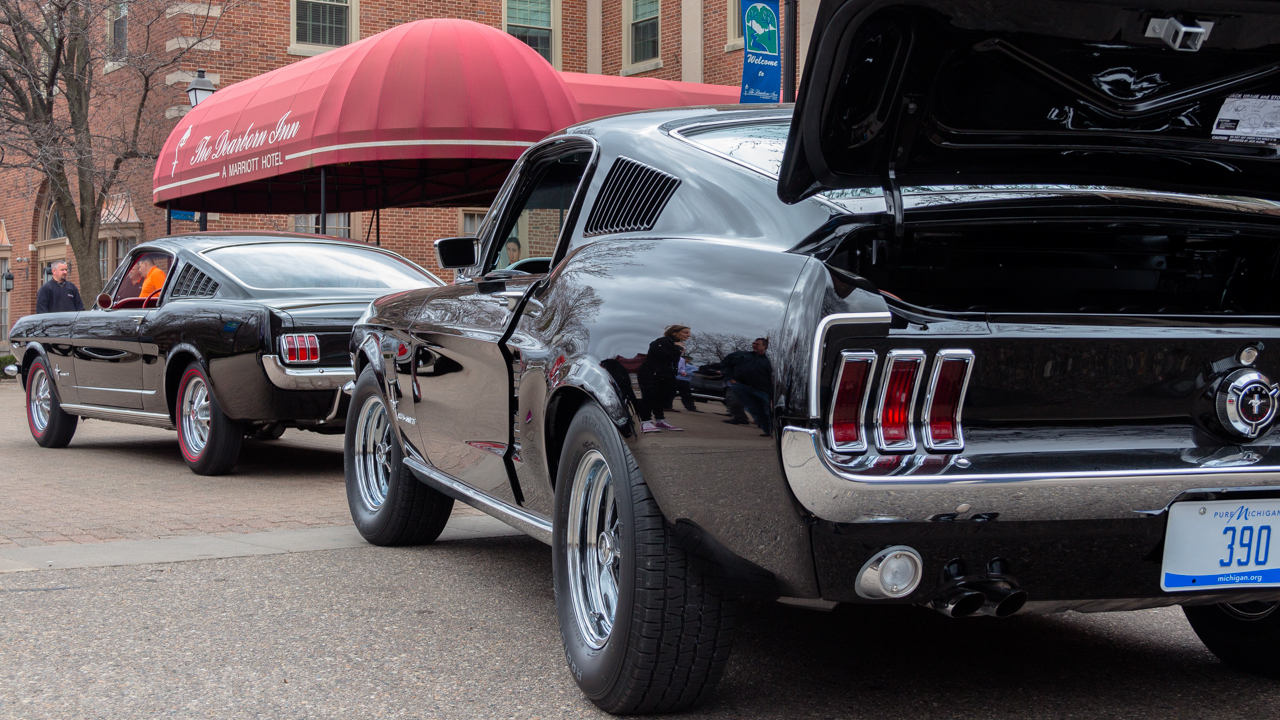
Moray Callum’s 1967 Mustang, foreground, preparing to depart from the Dearborn Inn.
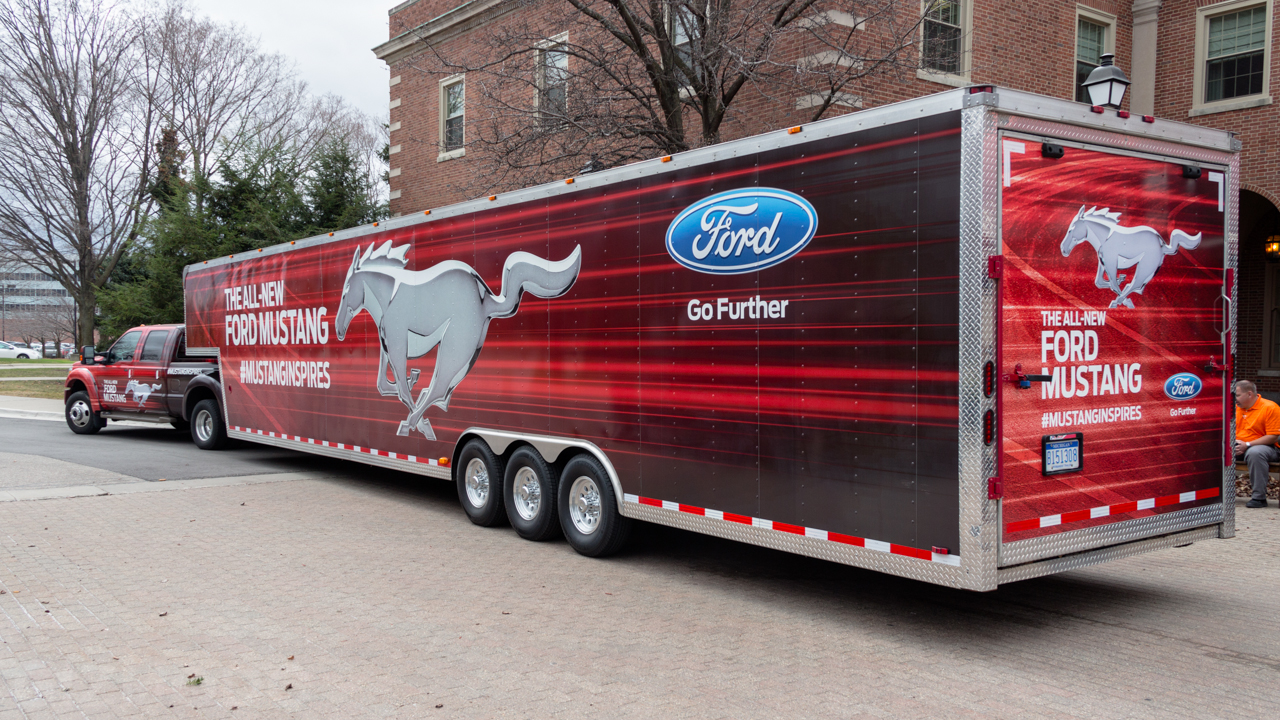
The chase truck and trailer we hoped we wouldn’t need.
It was grey and breezy when we lit out from the Dearborn Inn, a grand hotel Henry Ford built in 1931 for important guests who flew in to the private airport once located across Oakwood Boulevard at Ford’s world headquarters. Our itinerary had us crossing into Canada at Point Edward, rumbling across the toe of Ontario, and stopping for the night in Rochester, NY. As we thundered onto the highway a little after 10AM, Google Maps estimated we’d arrive by 4PM.
I rode with Chris in the ’65 for the first stint, with Motor Trend‘s Scott Burgess alongside Moray in the ’67. (You can read Scott’s two-part account of our journey here and here.) Chris is a lifelong Ford designer, having worked in the company’s design studios on every continent. He now oversees exterior and interior design for Ford in North and South America, most recently completing the design of the 2015 Mustang.
Like Moray, Chris grew up in the UK. I asked him how it came to be that the two designers in charge of rebooting America’s most iconic muscle car hail from the wrong side of the pond.
“They breed them well in the UK,” he replied.
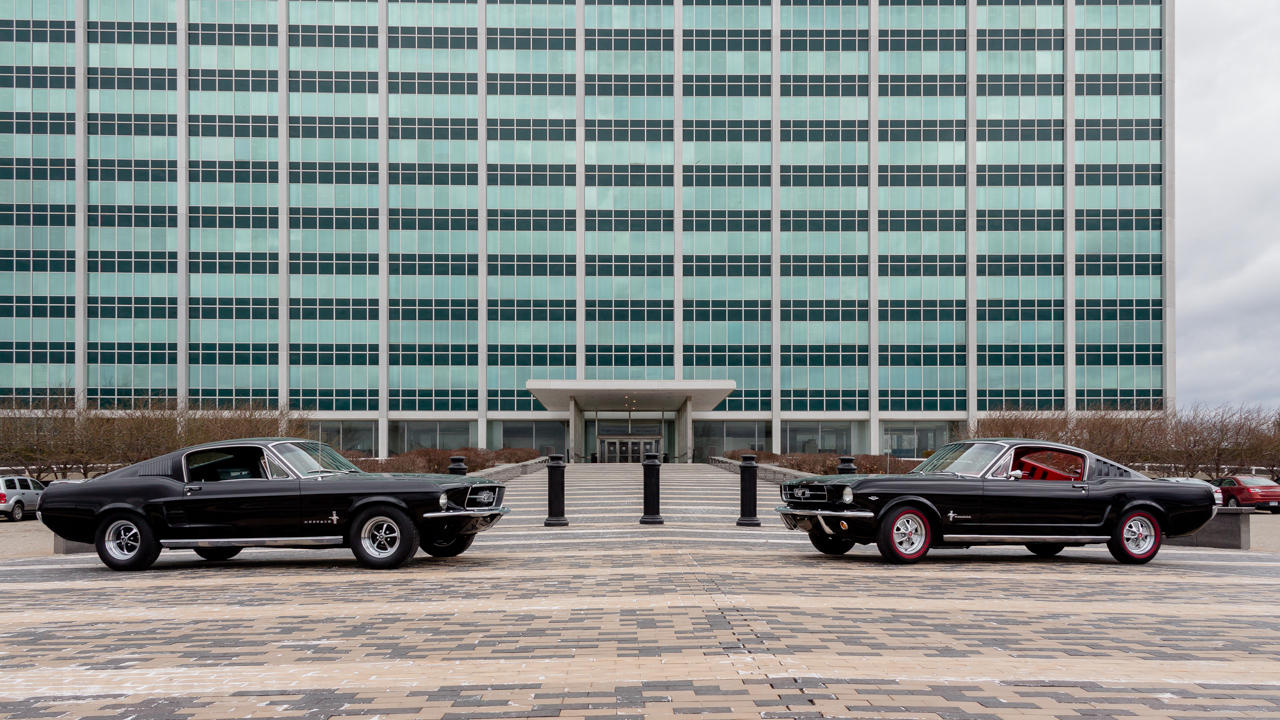
Stopping for a photo op outside Ford’s world headquarters. Moments after I took this shot, security rolled up. The front walk, photogenic as it may be, is a no-parking zone.

Chris Svensson’s 1965 Mustang, with a 2014 Mustang GT in the background, owned by a Ford designer.
Point Edward, Ontario
We crossed the Blue Water Bridge into Ontario. Motoring behind Moray, Chris evaluated out loud the lines of the 67 Mustang in front of us.
“If you look at the centerline silhouette, the middle of the car and how it looks, it’s fundamentally the same as that new car,” he explained. “It’s that fastback, dramatic, speedy looking profile that this car has, that everyone got so passionate about, and the new car has that too.”
The 50-year-old car was a touch unsteady in Canada’s stiff cross-winds. Chris kept both hands firm on the wheel. “We went back to that centerline silhouette and said, that was so iconic in the 65 and the 67 cars, we really need to reinvigorate that sporty silhouette. These [old] cars are important, they’re really key to how designers look at modern cars and trying to interpret what people find passionate about these things.”
He continued, as we made miles into Canada. “I think it’s the same with furniture, and fashion. You look at mid-60s modernist furniture, and it’s still so contemporary today. It’s very influential in modern furniture, and I think it’s the same for old cars too.”
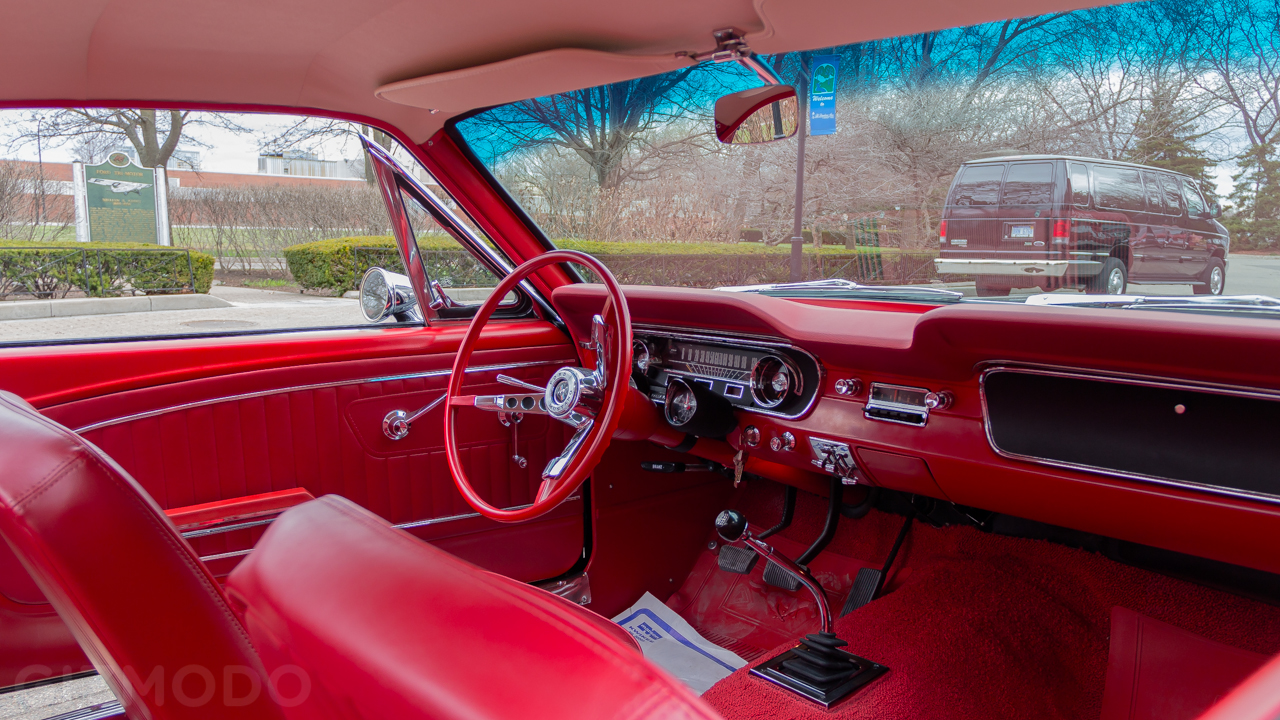
Chris’s 1965 Mustang interior.
Both of these iconic cars were designed in an era when automotive safety was a bare afterthought. The only halfhearted concession to life and limb in either car is a lap-only seatbelt like the one you buckled for takeoff on your last flight. I asked Chris how today’s safety requirements impact vehicle styling.
“It’s very confining,” he answered. “It limits your capabilities. But then, people have to use these cars and they have to be able to crash in these cars and be safe. I hate to say it, but if we have a crash in this car, it’s not gonna be good. Fasten your seatbelt as tight as you can.”
I cinched the belt snug, remembering an elderly aunt’s misguided belief that a seatbelt would “cut you right in two” in an accident. Given the many blunt and sharp metal surfaces one can hit one’s head on in a 65 Mustang’s interior, bisection seemed like the better option.
Our first fuel stop came less than two hours into our journey. These cars have a powerful thirst for dinosaur juice. And for electrons: When we went to pull out, Moray discovered his car’s battery had nearly drained. A young guy named Aaron pulled his lowered, decal-laden Acura up to the obstinate Mustang’s angry snout for a jump-start, the short hood and tiny motor of the modern car looking woefully inadequate next to the 67’s 390-cubic-inch juggernaut.
“Sick car,” he remarked.
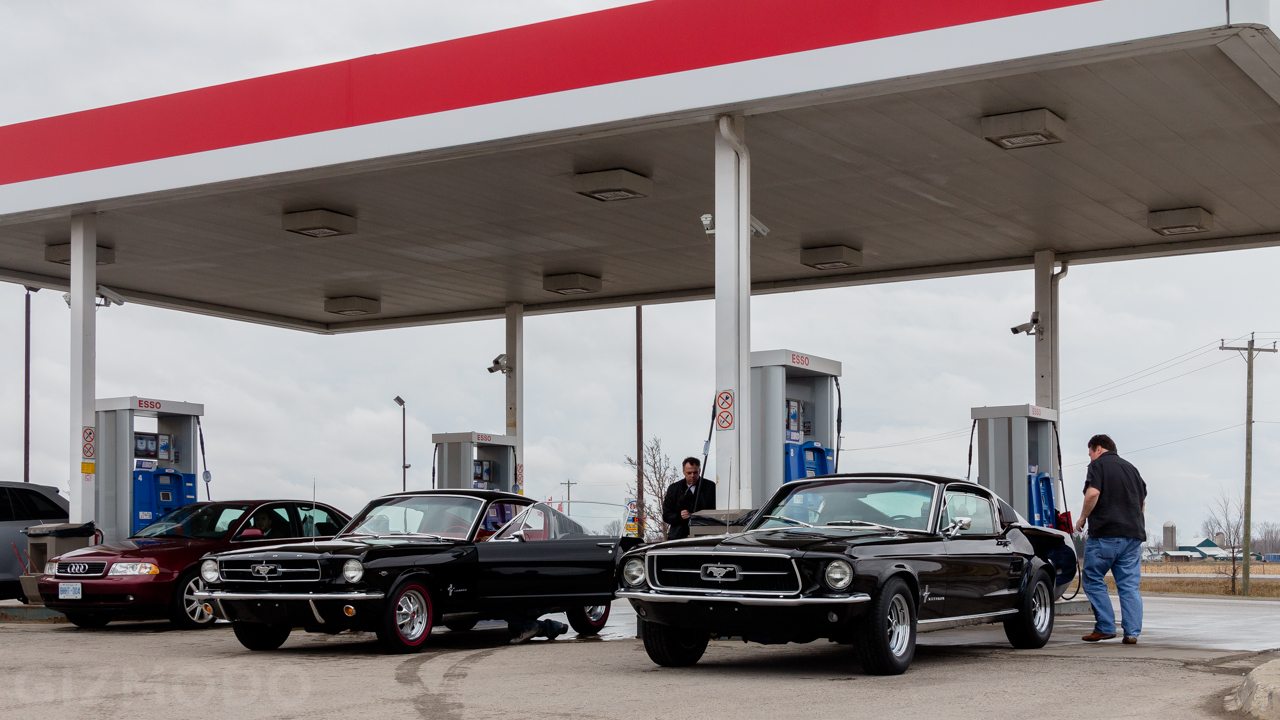
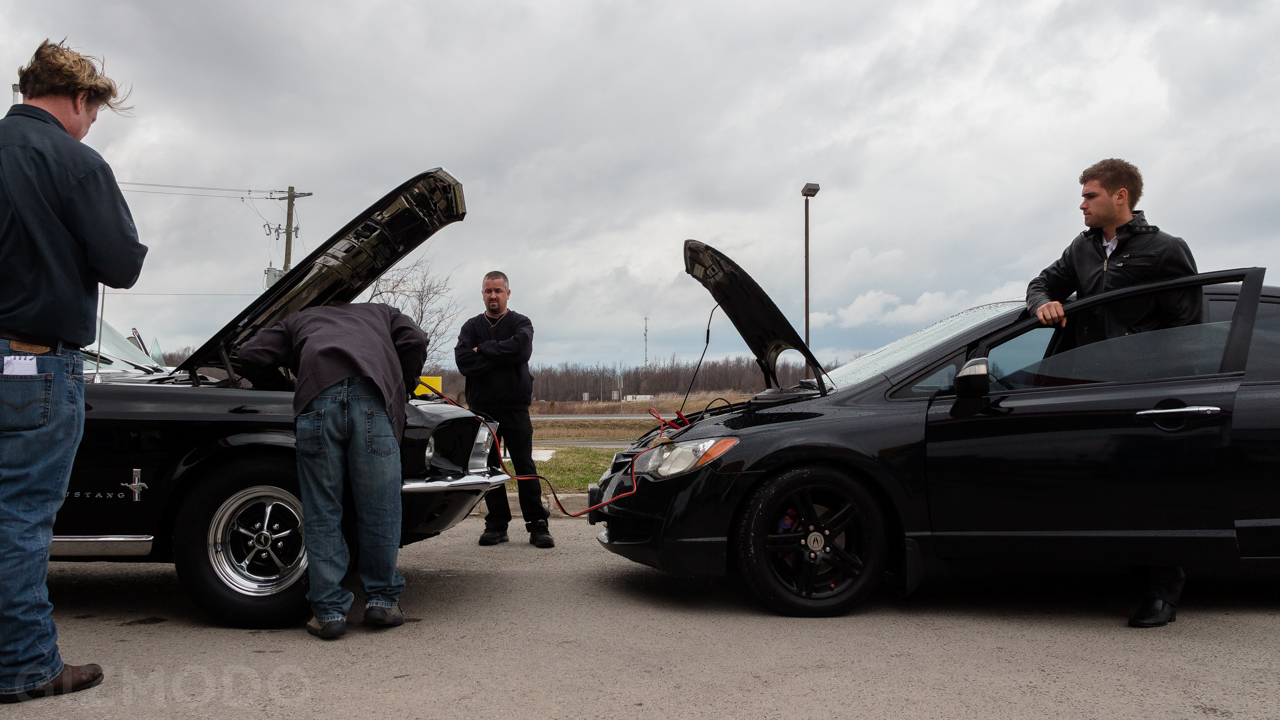
Woodstock, Ontario
Moray’s problems were just beginning. While the 67 hustled mightily past modern traffic, its alternator wasn’t keeping up — the further we drove, the more his battery drained. About an hour further into Canada and a drenching rain storm, with Moray in the lead and Chris and I running close behind, the 67’s taillights went dark. Moray’s engine had run the battery completely dead, and bereft of electrons, the Mustang stalled and scrubbed off speed at an alarming rate.
Chris swerved into the left-most lane, avoiding a Mustang-on-Mustang collision by mere inches, while Moray grappled with the dead 67. A sharp-eyed truck driver used his 18-wheeler to carve a gap in traffic so Moray, now coasting at about 30MPH and dropping, could muscle his car across two lanes to the shoulder.
Our chase crew loaded the downed Mustang on the trailer. We exited the highway in the town of Woodstock, Ontario, and bounced between three separate parts stores before locating one that carried an alternator that would fit a 67 Mustang. Then we waited for three hours while the shop negotiated a special delivery from its supplier. The shelf where they expected to find the part was empty.
Before Moray’s breakdown, I had asked Chris how design is changing with an evolving automotive market.
“They might not want this,” he said, gesturing at the dashboard of the 65. “But they might still want a space, a social space, they still want to get from A to B. How they do that, and what they use that social space for, might be very different to what I’m experiencing with this car.
He fiddled with an uncooperative windshield-wiper switch that wouldn’t turn off. “I love the experience of driving the car, shifting manually, that’s really exciting to me. They might want a space that’s a home away from home, where they can hang out with their friends and just chat. So it throws up different design criteria for our designers.”
“Design’s not easy,” he added.
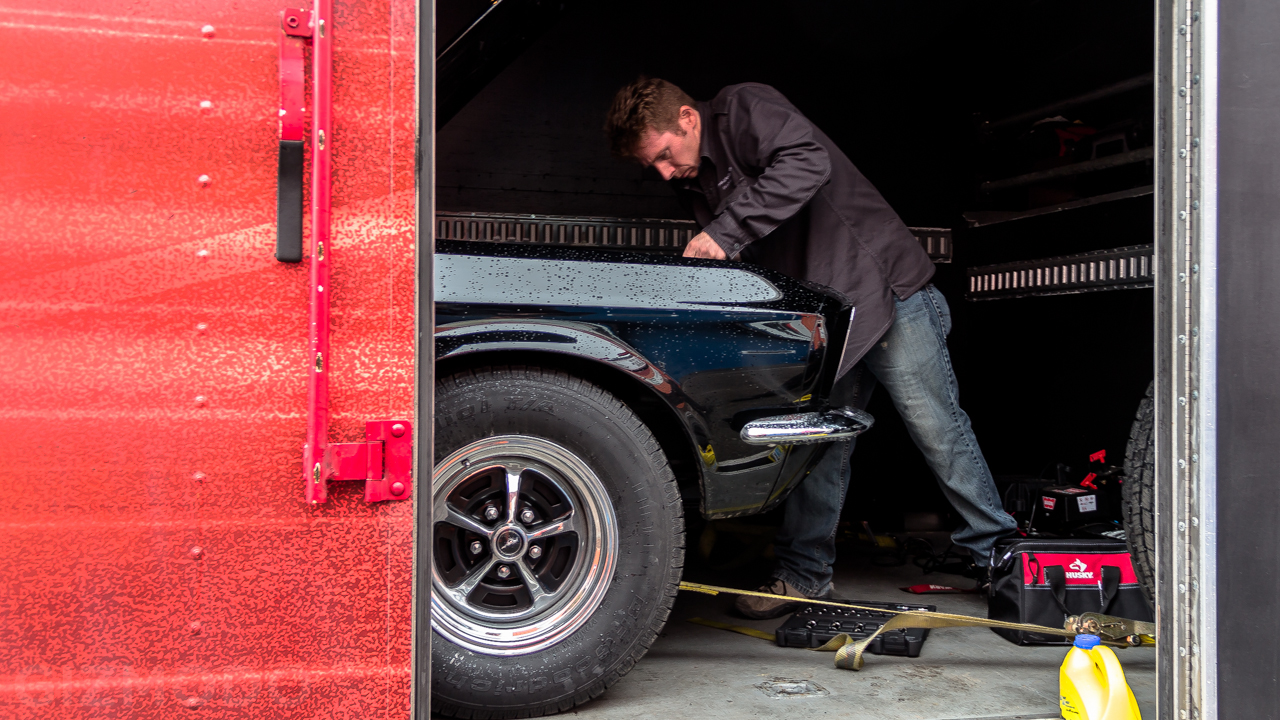
Matt Patrice works to replace the faulty alternator in the 67.
“When do you think we’ll get self-driving cars?” I asked Chris.
“Soon I think. I think we’ll have that situation within the next five to 10 years.”
“Will car design change when cars start to drive themselves?”
His answer was quick: “Yes. Yes, it will. Because the technology you need to put into the car to make it self-drive, some of those sensors and the functional element of the technology is quite big. So it will impact the visual elements of the car. And if you’re not driving yourself then do you need all of this information readily available to you?”
He pointed at the gauges on the dashboard. “Do you need to have instruments and steering wheels and satellite navigation? It drives a different solution for interiors. It’d be like riding a bus. You don’t need a sat nav and a steering wheel and all the paraphernalia that comes with the driving experience on a bus.”
The replacement alternator arrived after two hours, and Matt took less than 15 minutes to swap it in. But the 67 still wasn’t cured: a mysterious problem somewhere else in the system was preventing the battery from charging. Moray made an executive decision to buy two new batteries and an in-car charger. We would drive on one while the other charged in the truck, swapping the batteries when the 67 began to falter. There would be no giving up on this trip.
Also, since the trailer had entered Canada empty, customs regulations meant it could not leave the country carrying a car. We may share the world’s longest unfortified border with our friends to the north, but in matters of the law there is no flexibility.
So we rumbled on. The driving rain finally gave way to a copper sun, traffic dissipated, and girded with a brand-new battery, Moray played freeway cat-and-mouse with Chris’s steadfastly reliable 65. Chris and I found an oldies station on the 65’s AM radio, the 50-year-old, one-speaker system struggling to overpower the booming drone of a 289-cubic-inch V8 spinning a frantic 3,000 RPM.
St. Catharines, Ontario
As the sun set, Moray’s car began to falter again. Another jump start helped limp the 67 to a Wal-Mart parking lot. Matt tinkered some more, calling fellow Mustang experts to chase down theories. No matter what he tried, though, nothing convinced the 67 to straighten up and run right.
Moray purchased and installed yet another fresh battery, joking that he’d made the world’s first hybrid 1967 Mustang. We charged on into the night, making a run for the U.S. border and the freedom to load our hobbled 67 onto a trailer for the remainder of the drive to Rochester.
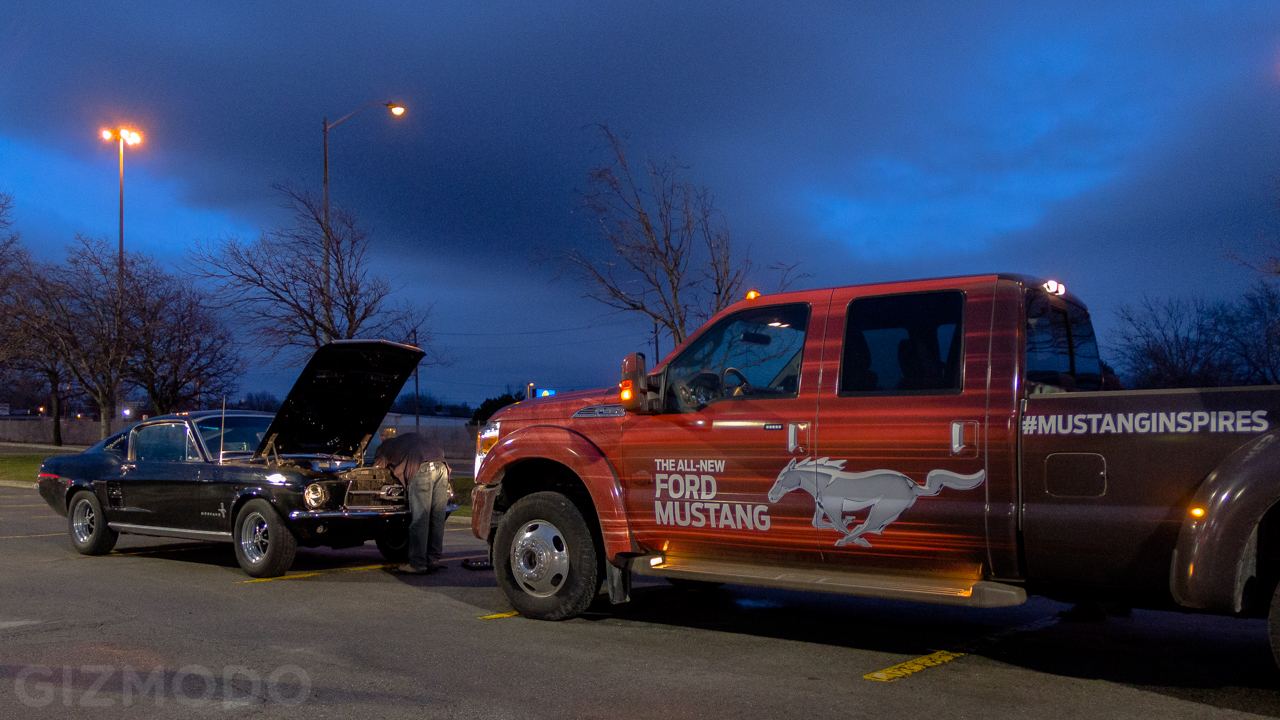
Wal-Mart parking lot somewhere on the wrong side of the U.S.-Canada border. 1967 Mustang about to gobble up its third battery of the day.
Rochester, NY
We crossed the Rainbow Bridge at Niagara Falls, losing the truck somewhere in the line for the border crossing. The border agent motioned for Chris to shut off his engine — the 65’s exhaust was simply too loud to shout over. After the problems we’d had with the 67, Chris and I shot worried glances at each other. But when the officer brusquely waved us through, the 65 started without incident.
We met up with Moray and the truck at the first gas station on the U.S. side of the border. The 67 was tucked into the trailer, Moray and Scott hunkered down in the back of the truck, and we charged on toward our hotel in Rochester. Chris’s headlights occasionally flickered off, so we stayed directly behind the trailer, never losing sight of its LED taillights.
It was midnight when we arrived.
Stay tuned for day two of the journey, where we continue our voyage from Rochester to NYC, and talk more about cars and the future of design.
